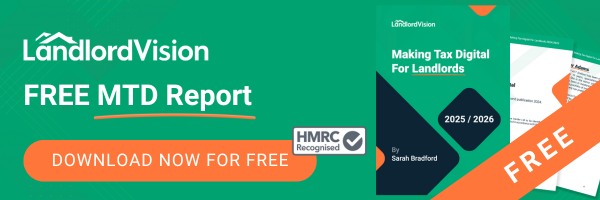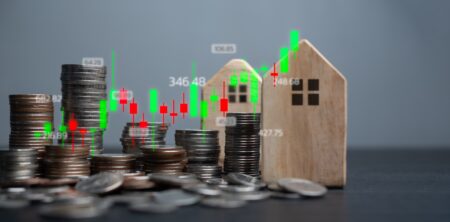
If you are a landlord in the UK, you will have probably come across the phrase ‘Making Tax Digital‘, or MTD for short, at some point. But what is Making Tax Digital, and more importantly, what does it mean for UK landlords?
Making Tax Digital is a government initiative that has been created to completely overhaul the tax system in this country. It will replace the old paper records and annual returns with digital record keeping and more frequent online submissions. This means big changes for landlords, especially those with multiple properties or significant rental income.
In this guide, we’re going to break all of this down so you will know everything you need to know about Making Tax Digital. We’ll cover everything from the key deadlines you need to keep in your calendar to the right compatible software. Whether you own one buy-to-let property or you have a major portfolio, this is your go-to beginners guide to Making Tax Digital.
What is Making Tax Digital?
The entire aim of Making Tax digital is to bring the tax system closer to real time, reduce errors and improve the way people and businesses handle their tax affairs. It’s important to establish that before we go into more details – all of these changes are for better speed and greater accuracy in a government department that has struggled to keep up with technology.
The main points that landlords need to be aware of are that under MTD, you will need to:
- Keep digital records of property income and expenses
- Use MTD software to submit updates to HMRC
- Send quarterly summaries of income and expenses
- Submit an annual End of Period Statement, and a Final Declaration
In theory, this will make everything much simpler for landlords, but as with any big change like this, there will be challenges. This article is designed to help you navigate those challenges with minimal fuss.
Who Does Making Tax Digital Apply To?
Making Tax Digital is being introduced in phases, and it impacts different types of taxpayers in different ways and at different times. Whether you’re a landlord, sole trader, or you run a limited company, it’s your responsibility to understand what is expected of you and when.
Here’s a quick breakdown of who MTD applies to:
VAT-Registered Businesses
- Since April 2022, all VAT-registered businesses are required to keep digital records and submit VAT returns using MTD-compatible software – regardless of turnover.
- This applies to both incorporated and unincorporated businesses.
Self-Employed Individuals and Landlords
- From April 2026, MTD for Income Tax Self Assessment (ITSA) will apply to:
- Sole traders and landlords with gross income over £50,000
- From April 2027, the threshold drops to those with income over £30,000
- If your total qualifying income (from self-employment, property, or both) is below £30,000, you’re currently exempt – though this may change in future.
Note for landlords: Your gross rental income counts toward this threshold, even if you also have a PAYE job or pension income.
Limited Companies (Corporation Tax)
- MTD for Corporation Tax is probably not going to be introduced.
- HMRC are working on a different approach to suit the varying needs of the corporate population.
- If you run a limited company that owns rental property, an initiative similar to MTD may be relevant in the near future.
What Does Making Tax Digital Look Like in Practice?
There are a few key changes that MTD will impose on how you manage your finances:
- Keep Digital Records of Property Income and Expenses
You’ll need to record each rental payment received and any allowable expenses (e.g. repairs, letting agent fees, insurance) in a digital format. - Submit Quarterly Updates to HMRC
Send a summary of your income and expenses every 3 months via MTD-compatible software. This replaces the single annual Self Assessment tax return. - End of Period Statement (EOPS) and Final Declaration
At the end of the tax year, you’ll confirm your totals, make any necessary adjustments (e.g. for accounting basis), and submit a final declaration – similar to your current self assessment.
What Counts as Digital Record Keeping for Property Income?
Don’t worry – you don’t have to electronically scan every receipt. What you are expected to do, though, is to keep an accurate, structured digital record using software that links to HMRC. The records you’ll need are:
- Dates rent was received
- Amounts (gross income)
- Expense types (e.g. mortgage interest, council tax, repairs)
- Totals by property (if applicable)
There will be some landlords that already use accounting software or apps that log this information, but if you don’t yet, it may be the time to consider making the switch.
What Software Do Landlords Need for Making Tax Digital?
In order to comply with MTD, you’ll need to use compatible software that can store digital records, create and send quarterly updates and generate your End of Period Statement and Final Declaration at the end of the year. There are a few of options available to you, including:
- Landlord Vision – MTD-compatible and purpose-built features for landlords managing rental income.
- Other options like Xero, FreeAgent, or QuickBooks
- Spreadsheets with bridging software – but this can get messy as your portfolio grows
Top Tip: If you manage multiple properties or have complex tax affairs, it’s worth investing in a landlord-specific solution that can automate much of the process for you. This will save you a lot of hassle in the long run.
What Are the Benefits of MTD for Landlords?
Initiatives like this are rarely well received – people don’t like having to change the way they work. However, following these new procedures may benefit landlords in the long run. Here are some potential benefits:
- Fewer mistakes and miscalculations in your tax return
- Greater visibility over your tax liabilities throughout the year
- Better financial planning – you’ll see how much you owe in near-real time
- More organised record keeping, especially if you own multiple properties
- Easier to provide documentation when applying for finance or mortgages
Many of you will already track your income digitally, and the transition may be much simpler than you anticipate.
When Do Landlords Need to Comply with MTD?
This all depends on your gross property income:
| Gross Property Income | MTD Deadline |
| Over £50,000 | April 2026 |
| £30,000 – £50,000 | April 2027 |
| Below £30,000 | Not yet required (TBC) |
If you’re already using software to submit VAT returns (as some incorporated landlords may be), MTD for VAT is already live.
Final Thoughts – Embrace the Digital Shift Now
We appreciate that many people will grumble about these enforced changes on how you work – but our advice is to embrace it early. Don’t wait until you have to make changes as that will just add to the stress of the situation. Start preparing now, and use MTD-compatible software as soon as you can.
Book a demo with Landlord Vision today, and you may be surprised about how straightforward these changes will be. You will even end up saving time in your day-to-day record keeping once you’re all set up.
FAQ Section
Q: Will I still need to submit a Self Assessment tax return?
A: You’ll need to submit an End of Period Statement and Final Declaration instead of a Self Assessment, but the same information is required.
Q: Is MTD mandatory for jointly owned properties?
A: Yes, but each individual must keep their own records and submit their own returns based on their share.
Q: Can landlords use free software?
A: Yes, but most landlords will find that they need something a little more complex and robust. HMRC does not provide any free software, unfortunately·
Q: What happens if I miss a quarterly update?
A: We understand that HMRC will introduce a points-based penalty system, so repeated non-compliance will probably lead to fines.
Check out our MTD Section for more info.




